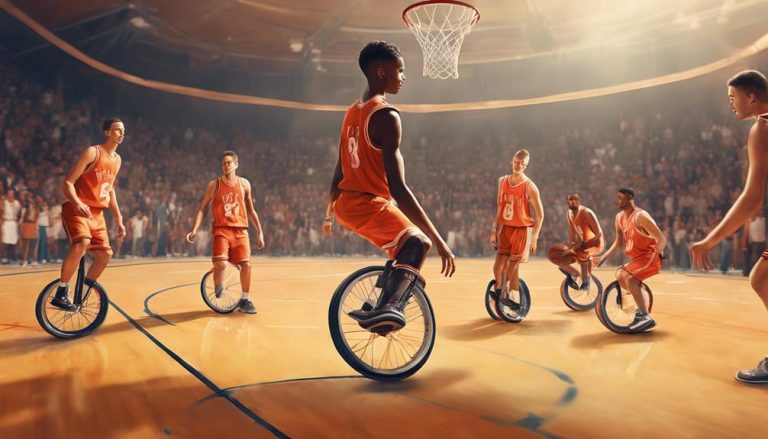General Rules of Track & Field
So, you think running in circles and jumping over obstacles is easy? Think again. Track and field is not just about sprinting to the finish line; it's a precise and disciplined sport that requires adherence to a multitude of rules and regulations. From the moment you step onto the track to the final whistle, every move is scrutinized and governed by a set of guidelines that ensure fairness and safety. But what exactly are these rules, and how do they impact your performance on the field?
Starting Procedures
When preparing for a track event, it's crucial to familiarize yourself with the starting procedures to ensure a fair and efficient start to the race. Starting positions play a vital role in the fairness of the competition. Athletes must adhere to the designated positions to ensure equal distances and angles for everyone. Understanding false starts is equally important. Jumping the gun can lead to disqualification, so it's essential to listen attentively to the starter's commands.
Moreover, mastering the usage of starting blocks can significantly improve your performance. These blocks provide a solid foundation for a powerful start, enhancing your acceleration off the line. Perfecting your reaction time is key. Reacting quickly to the starting gun can give you a competitive edge over your opponents. Training to anticipate the sound and synchronize your movements can make a significant difference in the outcome of the race.
Event Regulations
To maximize your performance in track and field events, understanding and adhering to event regulations is essential. Event timing and distance accuracy are fundamental aspects that ensure fair competition. Timing technology has advanced significantly, allowing for precise measurements that can make a difference in the outcome of races. It's crucial to familiarize yourself with the timing system used in each event to optimize your performance.
Athlete eligibility and age requirements are also critical considerations in track and field. Ensuring that you meet the eligibility criteria for a specific event is necessary to avoid disqualification. Age requirements are in place to maintain a level playing field and protect the safety of all participants. It's important to verify the age restrictions for each event you compete in to prevent any issues during competitions.
Field Event Rules
Ensure you grasp the essential rules governing field events in track and field competitions to enhance your performance and comply with competition regulations effectively. When it comes to jumping techniques, it's crucial to remember that in events like the long jump or high jump, fouls can occur if you step over the take-off board or fail to clear the bar. Understanding the correct approach and timing can make a significant difference in your results. Additionally, mastering different throwing styles is key in events like shot put, discus, and javelin throw. Each event requires specific techniques to maximize distance and accuracy. For example, in shot put, the glide and spin techniques can greatly impact your throw distance. Proper footwork, body positioning, and release are essential components to focus on. By honing your jumping techniques and throwing styles, you can elevate your performance and excel in field events on the track and field.
Relay Race Guidelines
When it comes to relay races, mastering the baton passing technique is crucial for success. Team coordination skills play a significant role in determining the outcome of the race. Developing a solid relay race strategy can give your team a competitive edge on the track.
Baton Passing Technique
Mastering the baton passing technique in relay races is crucial for maintaining speed and efficiency among team members. When focusing on baton passing, consider the following key points:
- Handoff timing: Perfecting the synchronization between runners is essential to execute a seamless baton exchange.
- Baton grip: Ensuring a firm yet flexible grip on the baton can prevent mishaps during the transfer.
- Relay exchange: Practice smooth transitions during the exchange to avoid losing momentum or dropping the baton.
- Acceleration phase: Emphasize a quick acceleration post-handoff to propel the team forward effectively.
Team Coordination Skills
To excel in relay races, effective team coordination skills are essential for seamless transitions and optimal performance. Communication tactics play a crucial role in ensuring smooth baton exchanges. Timed drills help synchronize the handoffs, reducing the risk of errors. Trust building among team members is vital to instill confidence in each other's abilities. Rhythm exercises can aid in establishing a harmonious flow between runners, enabling them to maintain a consistent pace throughout the race. By honing these skills, teams can enhance their overall performance and achieve better results. Remember, successful relay races not only require individual speed and skill but also depend greatly on the collective coordination and cohesion of the team.
Relay Race Strategy
Developing a well-thought-out relay race strategy is crucial for achieving optimal performance and securing victory in track and field competitions. To excel in relay races, consider the following:
- Team Communication: Clear and effective communication among team members is essential to execute smooth baton exchanges and maintain momentum.
- Speed Endurance: Each team member must possess the speed endurance required to maintain a fast pace throughout their leg of the race.
- Efficient Baton Passing: Practice precise and efficient baton passing techniques to minimize time loss during exchanges.
- Anchoring Strength: The anchor leg runner needs to have both speed and endurance to bring the team to victory in the final stretch.
Uniform and Equipment Standards
When participating in track and field events, athletes must adhere to specific uniform and equipment standards to ensure fair competition and safety. Uniform guidelines play a crucial role in maintaining equality among competitors. Athletes are usually required to wear uniforms that are not only comfortable but also distinguishable from other participants. This helps officials and spectators identify athletes easily during races or events. Uniform regulations may include restrictions on logos or designs that could provide an unfair advantage or be distracting to other competitors.
In addition to uniform guidelines, equipment requirements are also vital in ensuring a level playing field. From proper footwear to implements used in throwing events, each piece of equipment must meet certain standards to guarantee safety and fairness. For example, in throwing events like shot put or javelin, specific weight and dimension requirements are in place to prevent athletes from gaining an unfair advantage through equipment modifications. By adhering to these uniform and equipment standards, athletes contribute to the integrity and spirit of track and field competitions.
Officiating and Judging Protocols
Maintaining the integrity of track and field events relies heavily on precise officiating and clear judging protocols. Judging consistency is crucial to ensure fairness across all competitions, but officiating challenges can arise due to the fast-paced nature of the sport. To address these issues effectively, consider the following:
- Training Programs: Implement rigorous training programs for officials to enhance their skills and keep them updated on rule changes.
- Technology Integration: Utilize technology like electronic timing systems to improve scoring accuracy and reduce human error.
- Rulebook Accessibility: Ensure that officials have easy access to the rulebook for quick rule interpretation during competitions.
- Feedback Mechanisms: Establish feedback mechanisms for athletes, coaches, and officials to provide input on judging consistency and areas for improvement.
Frequently Asked Questions
What Are the Most Common Injuries in Track and Field and How Can They Be Prevented?
To prevent common track and field injuries, focus on proper warm-up techniques. Incorporate dynamic stretches and targeted exercises. Always listen to your body and avoid overtraining. Stay mindful of your form and gradually increase intensity to reduce the risk of injuries.
Are There Any Specific Dietary Recommendations for Track and Field Athletes?
Imagine your body as a high-performance engine—fuel it right! Nutrition tips for track & field athletes include balanced meals, high-protein snacks, and proper hydration strategies. Stay energized and hydrated to maximize your performance.
How Can Track and Field Athletes Improve Their Speed and Agility?
To boost your speed and agility, focus on speed drills and agility exercises. Incorporate interval training and plyometric workouts into your routine. Consistent practice, proper form, and targeted exercises will help you excel.
What Are Some Mental Techniques That Can Help Track and Field Athletes Stay Focused During Competitions?
Imagine yourself at the starting line. Use visualization techniques to see yourself succeeding. Focus on your breathing, using calming exercises to stay centered. These mental strategies will help you stay sharp and perform your best.
Are There Any Specific Recovery Strategies That Track and Field Athletes Should Incorporate Into Their Training Regimen?
To optimize your performance and prevent injuries, it's crucial to include specific recovery strategies in your training regimen. Incorporate proper rest, hydration, nutrition, and active recovery techniques to help your body heal and stay strong.






